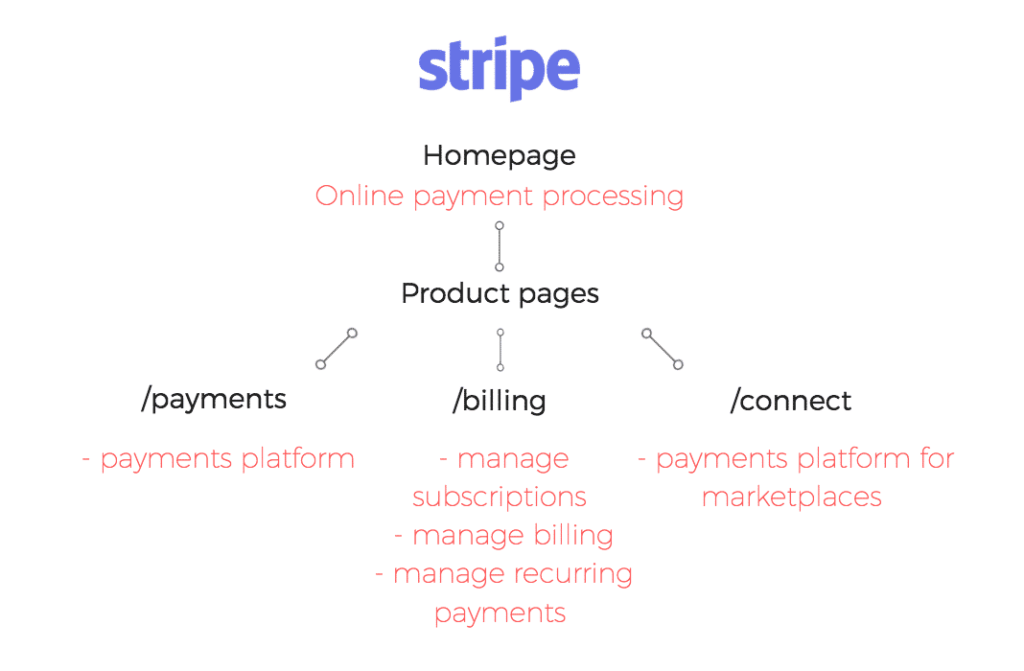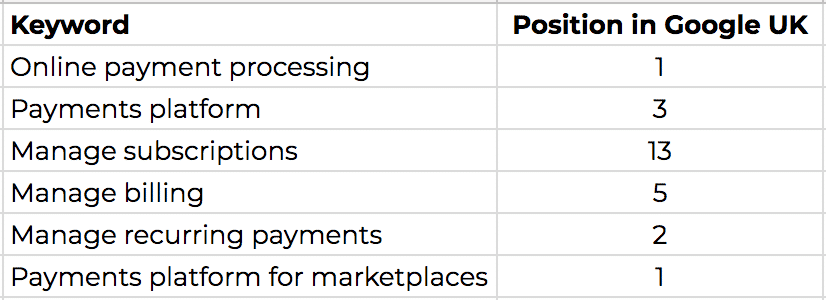So where better place to start our case study series?
Today I’m going to look at how Stripe use keywords to drive traffic; specifically ‘generic’ traffic.
Generic traffic is simply traffic from keywords that do not contain the company name (eg ‘payment provider’). Generic traffic is important because these are customers who might not know who you are as a brand.
Devising a good keyword strategy for your brand and website is the first thing you need to do with your SEO, so it’s where we’ll start our series too.
Hopefully there will be sone great learnings from Stripe that you can apply to your own website.
Who are Stripe?

Having an idea for a startup, getting accepted onto Y-Combinator’s accelerator programme, having customers like Facebook and Lyft, growing that business to a multi-billion dollar valuation… sounds like a dream right?
Well, for the founders of Stripe – an online payment processing software – this has all been a reality.
Ever since Stripe launched in 2010 they’ve grown from strength to strength, rapidly dominating an industry with a product that was genuinely needed.
But having a great product isn’t everything; you need to market that product to your potential customers. And we’re going to look today at how Stripe use effective SEO keyword targeting to drive traffic to their site.
First off… how much SEO traffic do Stripe get?

Although we can never be sure of the exact number, we estimate Stripe receive around ~2mil hits a month from organic search and rank for ~23k different keywords. After direct traffic, it’s their next biggest source of digital footfall.
Pretty important then right?
(NB: we use data from Similar Web for these figures; it’s the closest we can get without having a peak inside Stripe’s analytics!)
Stripe’s main keyword strategy
Like any good keyword strategy, Stripe have distributed important keywords for their business – keywords that will drive potential customers – across the relevant pages on their website.
To make it super simple to understand I’ve visualised it below…

(BTW – the keywords being optimised are highlighted in red)
Let me break the above down for you:
1. Homepage
So the homepage for Stripe is optimised for the keyword ‘online payment processing‘.
This makes complete sense; the homepage should be optimised for a keyword that sums up the entire product/service range of a business. Exactly what Stripe have done.

2. Product pages
So, Stripe also have a range of product/services pages as well. These are each individually optimised for additional keywords, such as ‘payments platform’, ‘manage subscriptions’, ‘payments platform for marketplaces’, etc…



Why is it important that keywords are placed onto multiple pages? Well, this is because it becomes difficult to optimise for more than two keywords on a single page.
The reason you can’t optimise for more than two is because:
– You want to add the keywords into the main SEO sections (eg the page title – as I’ve highlighted in red above) and it’s difficult to add more than two due to length restrictions.
– The content of the page needs to be specific around a topic to rank well. If you try and optimise for unrelated keywords on a single page, the content won’t be specific enough for Google to rank you.
Has this worked for Stripe? Let’s look at their rankings, not too shabby…

Extra keyword optimisation
So it doesn’t just stop there for Stripe; they’re also driving generic traffic via other tactics.

So what you can see here is that the SEO doesn’t just stop on Stripe’s homepage and services pages; they also rank well for pages elsewhere within the website, such as their partner pages and their blogs.
These are two really great SEO strategies for startups and new business websites.
In many cases, ranking for other brands you work with and ranking for blog/content-lead keywords are much less competitive than generic product/service type keywords.
So, when you’re just starting out in SEO and your authority as a website is low, look at tactics like these to drive traffic whilst you build in strength.
Let’s look at how Stripe rank for these phrases…

(look at how they actually rank position 2 for the term ‘Eventcude’ on it’s own!)
I love how their blog ranks for terms like ‘starting a real business’.
Imagine you’re starting an business, and looking to build a website for that business. There’s a really good chance you might need a payment solution to take payments. And Stripe might now be the first brand that springs to your mind!
It’s a great example of content marketing.
Lessons for other founders
Stripe are a great example of how startups can use SEO to their advantage, especially in the earlier days.
Develop a main keyword strategy that will pick the right keywords for each of your main products and/or services. These are your ‘evergreen’ phrases that will move up Google as your brand grows.
BUT in the meantime look at how at how you can create additional page to optimise for extra keywords.
What would you rather?
100 pages driving 10 visits each per month?
OR
10 pages driving 100 visits each per month?
Driving 10 visits to a page is much easier for a startup that driving 100 visits.
But there’s no reason you can’t have both, and drive 2000 visits per month 🙂
Hope you’ve found this case study useful. It would be great if you could feedback, either via the comment section below or on our Facebook Group ‘SEO for Startups‘.
(Which you should join BTW – it’s completely free and we do daily website SEO audits. You can submit your own website to the list and we’ll take a look over it).
Over and out!
Andy



.webp)